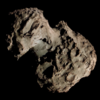| Discovery | |
|---|---|
| Discovered by | Kenneth S. Russell at the UK Schmidt Telescope, Australia |
| Discovery date | 16 June 1979 |
| Orbital characteristics | |
| Epoch | 2021-05-26 |
| Aphelion | 5.5 AU |
| Perihelion | 2.1 AU |
| Eccentricity | 0.44 |
| Orbital period | 7.5 yr |
| Inclination | 17.8° |
| Last perihelion | 2013-11-05? (unobserved) |
| Next perihelion | 2021-05-23?[1] (lost since 1985) |
83D/Russell (previously 83P/Russell) is a periodic lost comet in the Solar System with an orbital period of about 7.5 years. On the post-1988 orbit the comet probably does not get brighter than about apparent magnitude 21. The comet might come to perihelion in late May 2021, but the uncertainty in the comet's position is a few million km.
YouTube Encyclopedic
-
1/3Views:2 52334 040368
-
Game Maker History V1.1 - V8 (1999 - 2010)
-
General Relativity Lecture 8
-
EHS test logo
Transcription
Discovery
The comet was discovered on a photographic plate on 16 June 1979 by Kenneth S. Russell at the UK Schmidt Telescope, Australia, who described it as faint and diffuse, with a very low brightness of magnitude 18. Calculations of its orbit suggested a perihelion date of 27 May 1979 and an orbital frequency of 6.13 years.
The predicted 1985 apparition was observed by J. Gibson using the 1.5-m reflector at Palomar Observatory, California. He estimated the brightness of the nucleus at a very faint magnitude 19.5.
1988
On 9 August 1988 the comet passed 0.05 AU (7.5 million km) from Jupiter lifting perihelion (closest approach to the Sun) from 1.6 AU to 2.1 AU.[2] This greater distance from the Sun makes the comet fainter, less active, and more difficult to recover.
Its predicted appearance in 1991 was not observed due to unfavourable conditions and it was missed again in 1998. In 2006, although conditions were favourable, the comet was not relocated and hence it is now classified as lost.[3]
2021
In mid March 2021 the comet is expected to come to opposition in the constellation of Crater at around apparent magnitude 20.9.
See also
References
- ^ "83D/Russell Orbit". Minor Planet Center. Retrieved 2020-07-01.
- ^ Gary W. Kronk. "83P/Russell 1". Retrieved 22 February 2015.
- ^ Seiichi Yoshida (2009-09-12). "83D/Russell 1 (2006)". Seiichi Yoshida's Comet Catalog. Retrieved 2020-07-02.
External links
- 83D/Russell 1 – Seiichi Yoshida @ aerith.net


